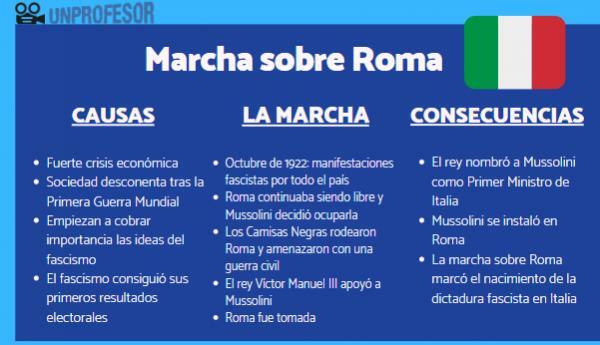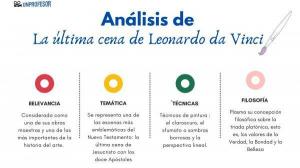The March on Rome by MUSSOLINI
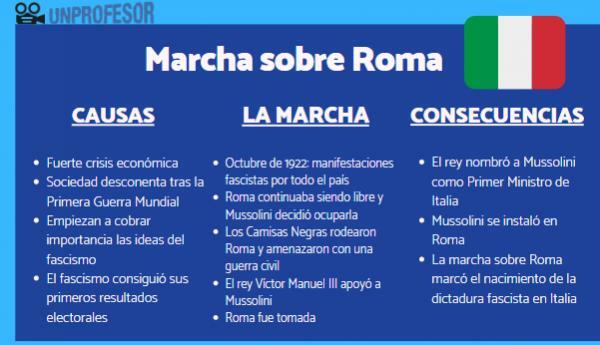
In the 1920s began to have great relevance in Italy the fascist movement led by Benito Mussolini, being an anti-democratic and authoritarian ideology that sought absolute power. One of the most important events of Italian fascism was the march on Rome, being the moment in which Italian parliamentarism and therefore the democracy of Italy came to an end. To talk about it in this lesson from a TEACHER we're going to talk about what was the march on rome.
To know what the march on Rome was, it is important that we understand the background and causes of this event. Like any moment of great relevance to human history, the march on Rome is the consequence of a series of antecedents, these being facts that over time led to this action by the party led for Benito Mussolini.
Since 1919, and due to a strong economic and social crisis throughout the world, the ideas of fascism, this being an ideology defended by a politician and former military man named Benito Mussolini. Mussolini began to increase the
violence against socialists and communists, blaming them for all the problems in Italy, even though the economic troubles were a world event in which a local government had little power. Even so, the violence was not only for these two groups, although most of the violence was for them because of their predominant role in Italian politics, but they were also carried out violent acts against liberal parties and against anyone who defended democracy.Members of fascism had formed the so-called squadristi, being squads whose actions were based on attack any public event of non-fascist ideology and end the act in the most violent way possible. Through fires and assassinations, the fascists became a frightening group, but, by their populist measures, they were every once better seen by the population dissatisfied with the situation and especially by the people who had suffered the worst during and after the First World War.
After two years of violent attacks, fascism got its first results, with a seat in the 1921 elections; it seemed that the role of fascism was growing. The communists and socialists saw dangerous the arrival of a party that attacked in a terrorist way on a regular basis and the Conservatives, although at first they supported the movement for its attacks on the opposition, they soon realized that the fascism he wanted to end democracy. The fear of the conservatives and liberals led them to think that a civil war was possible.
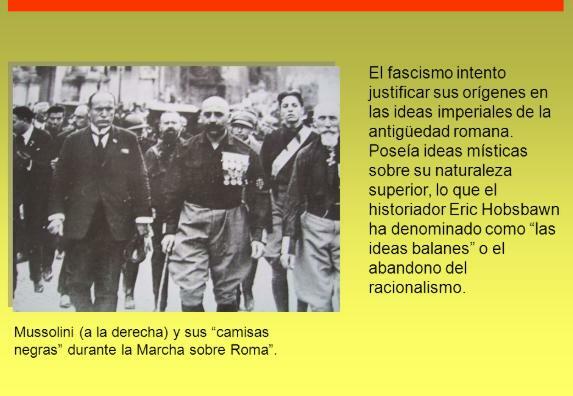
Image: Slideplayer
With growing popular support, in October 1922 Mussolini decided to take the next step in his quest for power by convening fascist demonstrations by all the big cities of Italy. At this point, the fascists had already achieved, through threats and violence, that almost all the great leaders of the northern Italian area resigned, achieving as a result to dominate the northern part of the state Italian.
Almost all the big cities were controlled by fascism, but the capital Rome was still free and, therefore, Mussolini gave the order to all his followers to march towards the Italian city to take power.
From all over Italy the fascists marched to Rome, surrounding the city and threatening with the weapons they had any citizen who did not join. At the end of October 1922 the Black Shirts (a voluntary militia used by Mussolini to commit assassinations) surrounded the city and threatened to start a civil war if the Italian authorities did not give way to the city of Rome.
For days, the number of Italians around the city was increasing and the President Luigi Facta, of the Italian Liberal party, he asked for a State of Siege to protect the city. The request of the Italian president was rejected by King Victor Emmanuel III, due to the fear that the king had to the popular support obtained by Mussolini. The king's rejection caused the army will not act against the fascists and that they entered Rome shortly after to take power in an undemocratic way in the so-called march on Rome.
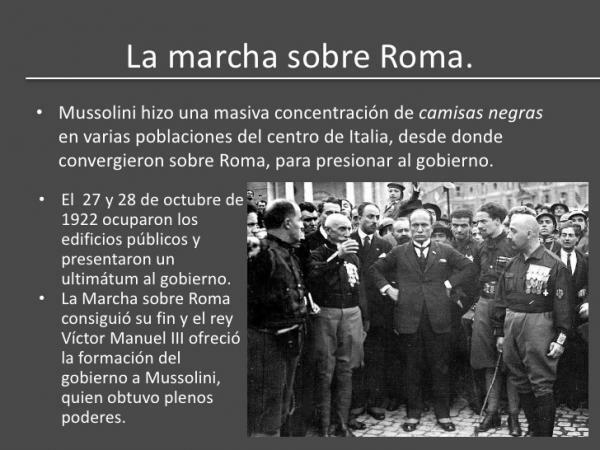
Image: Slideshare
To finish this lesson on what the march on Rome was, we must talk about the outcome of Mussolini's action and about the consequences that he had this symbolic act in the later years of Italy.
Mussolini and his followers entered Rome to take it. Later it would be said that this was a heroic act based on the people to prevent a socialist revolution, these elements of propaganda being key to any fascist government. Mussolini just wanted absolute power, being able to do what he wanted without the need for any kind of parliamentary support.
King Victor Emmanuel III appointed him Prime Minister of Italy and, a few days later, a huge number of armed Blackshirts and he marched in a parade to celebrate the seizure of power and the victory of fascism in Italy.
After that, Mussolini settled in Rome and during the following months his followers were making movements of different kinds to be able to take control of all Italy little by little. The march on Rome marked the birth of the fascist dictatorship in Italy, which was maintained until end of World War II, the death of Mussolini and the return to democracy.
